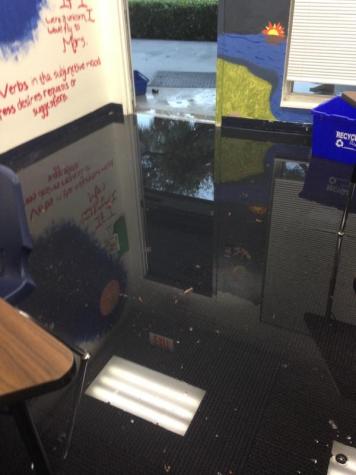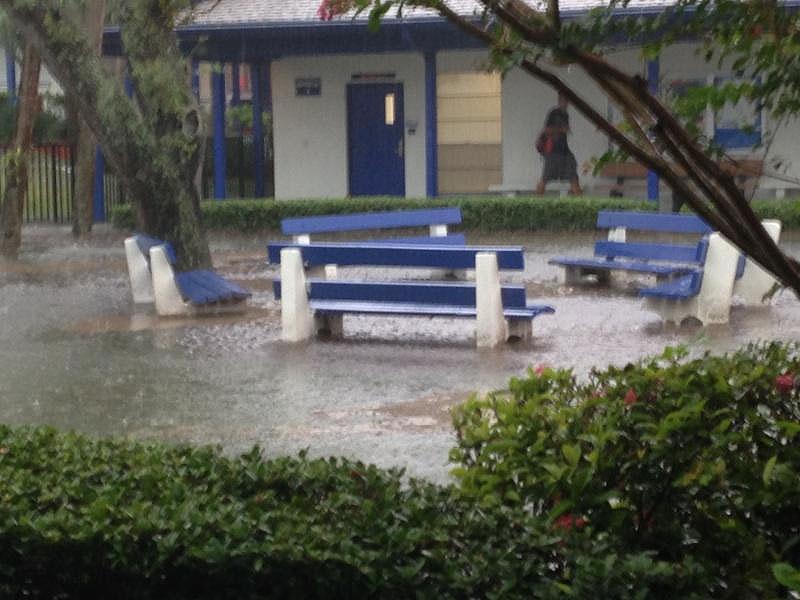Figuring Out the Flood Solution
The quad’s benches were several inches underwater during the deluge.
It does not take long to understand “Florida weather.” Most summer days it rains, but these mini storms usually end in about twenty minutes. The particular storm that deluged the middle school campus on Friday, August 15 was not a mini storm but one that would present a challenge to The Benjamin School. Scheduled for that evening was the Open House for new middle school students. However, the early evening downpour forced the administration to cancel the event. Why? Well, as people who live in Florida, most would expect the storm to be over soon, and they would go home to get ready for the open house. That is not what happened. As a few people might know, most of the quad, including the classrooms, were flooded. Most teachers were expecting visitors to their classrooms, so they had no idea what was going on outside until water started seeping into under the doors.

Dr. James’ classroom floor was completely covered with water after the storm.
“The problem is caused by an overabundance of water in the drainage system,” said Mr. Charles Hagy, head of the middle school, who was also caught in the flood. “It’s a problem that the school is looking very aggressively at correcting.” According to Hagy, there was about seven inches of rain. “There was so much water, that we couldn’t have kept it [the water] out anyway.” Hagy also mentioned that the rain fell so quickly that there was not enough time to get the sandbags out.
This event, and several floods before, have lead our School close to a solution: tiling. TBS is hoping that tiling is the answer in the event that water again enters the quad classrooms. The tiles Benjamin will purchase are supposed to be sealed in order to be more water resistant than regular tiles. This may be good to empty the rooms once they are flooded, but what about preventing the flooding altogether? Is there something that can be done, construction-wise, to spare future damage, teacher displacement, and the canceling of important school functions?
According to Mr. Hagy, more weather radios were purchased to warn staff of incoming storms and the facilities staff has agreed to stay on campus until all sandbags have been placed in the quad if rain is approaching. The Maintenance Department has already helped the garden in the sixth-grade area by building a stone wall, about two-and-a-half feet tall. This helps the garden with rain and keeps it elevated in case of another flood. Regarding the wall around the sixth-grade garden, Mr. Hagy said some construction similar to that wall could possibly help the quad. In years past, when the garden was at ground level, storms would carry the dirt down the hill and into the sixth-grade locker area. So what does the future hold for the quad? “The school needs to allocate funds for the ‘fix’ of the flooding problem,” said Mr. Marshall Mullnix, chair of the history department and resident of one of the quad classrooms. On August 15, his room was fortunately only flooded in one corner. “I have not seen the plans for tiling, but anything will help,” said Mullnix, who is also eager to find a solution.
“A proper drainage system will keep us safe from water incursions into our rooms and protect us from the aftermath of mildew problems,” added Mrs. Kathleen Devine, middle school English department chair. Mrs. Devine’s classroom was one of the most flooded. Although all of the water was eventually taken out of her room, her classes had to go to the RAAP room because of the smell. “We have been promised that [the flooding of the quad] will be a top priority to fix,” said Mr. Hagy.
The tiling is coming to our school soon, but whether this is a long-term solution will be up to, well, the weather.





